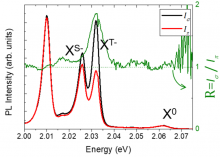One of the most promising properties of novel 2D semiconductors based on transition metal dichalcogenides are related to the possibility of manipulating the spin and valley (momentum) degree of freedom of electrons with circularly polarized light. Nevertheless, optical excitation mostly generates excitons species with inherently short lifetime and spin/valley relaxation time. In this work, which is a collaboration between the Electrons Photons Surfaces group and the LPCNO (Toulouse), the NIMS (Japan) and the University of Rochester (USA), we demonstrate a very efficient spin/valley optical initialization of resident electrons in n-doped WSe2 and WS2 monolayers by using a continuous wave laser at appropriate excitation densities. The results have been recently accepted for publication in the journal Nature Communications.
Transition metal dichalcogenides (TMD) such as MoS2, MoSe2, WS2, or WSe2 are layered semiconductors with promising applications in optoelectronics and spintronics. In the monolayer (ML) limit, they become direct band gap semiconductors, with gaps located at the six corners of the hexagonal Brillouin zone (K valleys). Remarkably, they exhibit a strong light-matter interaction governed by tightly bound excitons with binding energies of several hundreds of meV. In addition, they are characterized by a strong spin-orbit coupling and a lack of crystal inversion symmetry resulting in original spin/valley properties. Among them, chiral optical selection rules dictate that circularly polarized light can photo-generate carriers in either K or K’ valleys with either spin up or spin down, i.e. the so-called spin/valley pumping. Thus, TMD MLs were quickly considered as an ideal platform to control both spin and valley degrees of freedom with potential applications in quantum information processing.
Nevertheless, light excitation usually yields neutral excitons and using these photo-generated species to encode spin or valley information is inherently limited by both their short recombination time ( ps) and their very fast spin/valley relaxation time induced by electron-hole exchange interaction ( ps). Recently other strategies have been proposed using longer lived excitonic species such as dark excitons, dark trions or interlayer excitons in heterostructures. Another promising route consists in using resident electrons or holes in doped monolayers. Beyond its obvious advantage for future devices as compared to the manipulation of excitons, the spin/valley relaxation of resident carriers is prevented by spin/valley locking and is not governed by efficient exchange interaction like for excitons. Spin/valley relaxation times as long as 100’s ns to several μs for electrons and holes have been measured in WSe2 using time-resolved Kerr experiments and spin/valley noise spectroscopy.
In this work, we demonstrate a very efficient spin/valley pumping mechanism which yields very large polarization for resident electrons in n-doped WSe2 and WS2 following a circularly polarized excitation without applying any magnetic field. In contrast to pump-probe experiments, we use continuous-wave (cw) laser excitation that leads to a dynamical building-up of this very large polarization. We use the degree of circular polarization of the photoluminescence associated with negative trions as probes of the polarization of electrons. In n-WSe2 we measure a very large positive circular polarization 90% for the triplet trion and a negative polarization −40% for the singlet trion. Remarkably, the total intensity of the triplet trion following circular excitation is more than four times larger than the total intensity following linear excitation. Using simple models of trion formation, we demonstrate that all these observations are consistent with a very efficient spin/valley pumping of resident electrons and give an estimate of 80% for polarization.
This work is thus an important step towards the development of valleytronic devices based on TMD MLs.
Publication
Spin/Valley pumping of resident electrons in WSe2 and WS2 monolayers, C. Robert, S. Park, F. Cadiz, L. Lombez, L. Ren, H. Tornatzky, A. Rowe, D. Paget, F. Sirotti, M. Yang, D. V. Tuan, T. Taniguchi, B. Urbaszek, K. Watanabe, T. Amand, H. Dery and X. Marie, Nature Communications (2021).


